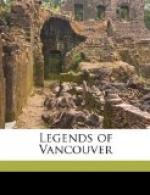But this wild tale, fortunately, had a most beautiful conclusion. The Four Men, fearing that the evil heart imprisoned in the stone would still work destruction, said: “At the end of the trail we must place so good and great a thing that it will be mightier, stronger, more powerful than this evil.” So they chose from the nations the kindliest, most benevolent men, men whose hearts were filled with the love of their fellow-beings, and transformed these merciful souls into the stately group of “Cathedral Trees.”
How well the purpose of the Sagalie Tyee has wrought its effect through time! The good has predominated, as He planned it to, for is not the stone hidden in some unknown part of the park where eyes do not see it and feet do not follow—and do not the thousands who come to us from the uttermost parts of the world seek that wondrous beauty spot, and stand awed by the majestic silence, the almost holiness of that group of giants?
More than any other legend that the Indians about Vancouver have told me does this tale reveal the love of the coast native for kindness and his hatred of cruelty. If these tribes really have ever been a warlike race I cannot think they pride themselves much on the occupation. If you talk with any of them, and they mention some man they particularly like or admire, their first qualification of him is: “He’s a kind man.” They never say he is brave, or rich, or successful, or even strong, that characteristic so loved by the red man. To these coast tribes if a man is “kind” he is everything. And almost without exception their legends deal with rewards for tenderness and self-abnegation, and personal and mental cleanliness.
Call them fairy-tales if you wish to, they all have a reasonableness that must have originated in some mighty mind, and, better than that, they all tell of the Indian’s faith in the survival of the best impulses of the human heart, and the ultimate extinction of the worst.
In talking with my many good tillicums, I find this witch-woman legend is the most universally known and thoroughly believed in of all traditions they have honored me by revealing to me.
DEER LAKE
Few white men ventured inland, a century ago, in the days of the first Chief Capilano, when the spoils of the mighty Fraser River poured into copper-colored hands, but did not find their way to the remotest corners of the earth, as in our times, when the gold from its sources, the salmon from its mouth, the timber from its shores are world-known riches.
The fisherman’s craft, the hunter’s cunning, were plied where now cities and industries, trade and commerce, buying and selling, hold sway. In those days the moccasined foot awoke no echo in the forest trails. Primitive weapons, arms, implements, and utensils were the only means of the Indians’ food-getting. His livelihood depended upon his own personal prowess, his skill in woodcraft and water lore. And, as this is a story of an elk-bone spear, the reader must first be in sympathy with the fact that this rude instrument, most deftly fashioned, was of priceless value to the first Capilano, to whom it had come through three generations of ancestors, all of whom had been experienced hunters and dexterous fishermen.




